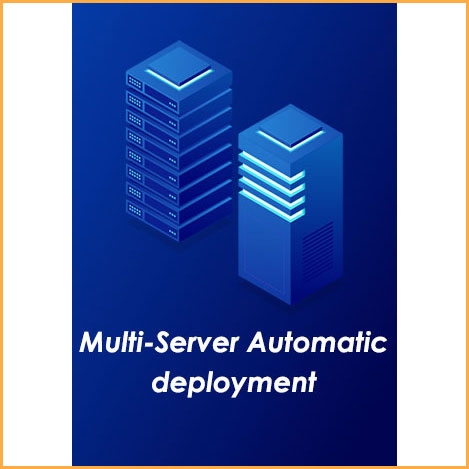Multi-Server Automatic Deployment
Buy Multi-Server Automatic Deploymente now!
Multi-Server Automatic Deploymente can offer a higher level of reliability and availability than a single-server environment.
You will receive your code to redeem in your account within minutes by eMail. In order not to miss out the mail, please check the spam or junk mail folder too!
Please note: The download link will be sent to you via delivery eMail after you order.
What is a Multi-Server Automatic Deployment?
A Multi-Server Automatic Deployment is a type of server infrastructure that uses multiple physical servers to provide users with access to a variety of services and applications. The main advantage of using a Multi-Server Automatic Deployment is that it can offer a higher level of reliability and availability than a single-server environment.

In addition, a Multi-Server Automatic Deployment can offer a higher level of performance than a single-server environment because the load can be distributed across multiple servers.
Benefits of a Multi-Server Automatic Deployment.As you consider a Multi-Server Automatic Deployment it is important to understand why it is a good idea for your business.
There is a wide range of benefits to gain:
- Increased Reliability and Availability
If one server in a Multi-Server Automatic Deployment goes down, the other servers can continue to provide access to the services and applications that users need. This means that there is less downtime and fewer disruptions for users. - Increased Scalability and Resilience
A Multi-Server Automatic Deployment can offer a higher level of scalability and resilience than a single-server environment. The load can be distributed across multiple servers, which means that the infrastructure can handle more traffic and is less likely to crash. - Reduced Costs
A Multi-Server Automatic Deployment can be more cost-effective than a single-server environment. By using multiple servers, you can spread the cost over multiple devices. In addition, you can use lower-cost hardware using multiple servers than you would in a single-server environment.
Planning Your Multi-Server Automatic Deployment
As you move to a Multi-Server Automatic Deployment, consider the strategic priorities and tactical execution of your plan:
- Strategic Priorities
There are a number of big-picture, strategic considerations involved with planning a Multi-Server Automatic Deployment. As with most things, having a rock-solid strategy is key to success. - Forecast for Growth
When planning a Multi-Server Automatic Deployment, it is important to keep your strategic priorities in mind. One of your top priorities should be forecasting growth. You need to make sure that the infrastructure can handle future traffic loads and that you have enough servers to meet the demand. - Fit Your Budget for Now
You also need to be mindful of your budget. You don't want to invest in servers that you won't be able to afford in the long run. It is important to find a balance between investing in enough servers to meet future demand and keeping your costs under control.
Start with a smaller number of servers and then expand the infrastructure as needed. This will allow you to scale infrastructure as needed without spending too much money upfront. - Remember Access Controls
Another thing to keep in mind when planning a Multi-Server Automatic Deployment is access controls. You need to make sure that only authorized users have access to the services and applications that they need. You can do this by using authentication and authorization mechanisms such as username/password authentication or role-based access controls. - Define Your Goals
Next, define your goals. What do you want to achieve by using a Multi-Server Automatic Deployment? Do you want to provide users with higher levels of availability and reliability? Or do you want to offer a more scalable and resilient infrastructure? Once you've defined your goals, you can start to plan how you will achieve them. - Create a Detailed Plan
Once you've chosen the right hardware, you'll need to create a detailed plan for how you will build your Multi-Server Automatic Deployment. This plan should include all of the steps that you need to take, from choosing the right operating system to configuring the network. - Tactical Execution
Now that the strategic priorities have been addressed and your plan is aligned with your business goals, it is time to get to work executing your plan. - Build and Test Your Multi-Server Automatic Deployment
It's time to start building your Multi-Server Automatic Deployment based on the plan identified during the strategic priorities phase. Once it is built, you must also test the environment before deploying it into production. This will help ensure that everything is working as expected and that there are no surprises when users start to use it. - Deploy Your Multi-Server
Once you've tested your Multi-Server Automatic Deployment and you're confident that it's ready


